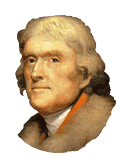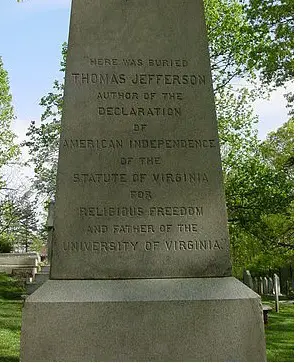Third President of the United States
| Term: | 1801-1809 |
| Party: | Democratic-Republican |
| Full name: | Thomas Jefferson |
| Born: | April 13, 1743 |
| Birthplace: | Albemarle County, Virginia |
| Nickname: | The Apostle of Democracy The Man of the People The Sage of Monticello The Pen of the Revolution Father of the Declaration of Independence |
| Education: | Gentleman’s education at the College of William and Mary |
| Vocation: | Lawyer |
| Height: | 6 ft 2 1⁄2 in (189 cm) |
| Hair Color: | Red |
| Eye Color: | Hazel |
| Religion: | Deism |
| Spouse: | Martha Wayles Skelton Jefferson |
| Children: | Martha Wayles (1772-1836) Jane Randolph (1774-1775) A stillborn son (1777) Mary Wayles (1778-1804) Lucy Elizabeth (1780-1781) Lucy Elizabeth (1782-1785) |
| Date of death: | July 4, 1826 |
| Place of death: | Monticello, Virginia |
Facts about Thomas Jefferson
Violinist. Architect. Polymath. Freedom fighter. Philosopher. Secretary of State. Polyglot. Lawyer. Governor of Virginia. Social scientist. President. Patriot. Genius. Founder of the world’s oldest political party. Ambassador. Scholar.
 These were one of the many terms used to describe Thomas Jefferson throughout his life – and even after his death. However, Jefferson considered none of the above ranking among his finest achievements in life. Instead, sometime before his death, Jefferson penned the following epitaph for his gravestone.
These were one of the many terms used to describe Thomas Jefferson throughout his life – and even after his death. However, Jefferson considered none of the above ranking among his finest achievements in life. Instead, sometime before his death, Jefferson penned the following epitaph for his gravestone.
Author of the Declaration of American Independence
Of the Statute of Virginia for Religious Freedom
And father of the University of Virginia”
Perhaps, more than anything else, this was the reason why in the eyes of many, Thomas Jefferson remains as one of the greatest American Presidents in history. Ultimately, his legacy transcends his enormous political contributions.
 The Declaration of Independence, which a 33-year old Jefferson crafted in just 17 days, is considered by many as one of the greatest declaration of human rights in recorded history. The powerful phrase “all men are created equal,” in particular, has traversed the breadth of time and distance to inspire thousands, if not millions, since its inception. Its sheer simplicity stands in stark contrast to its complex implications on life, morality, natural rights, civil liberties and political rights.
The Declaration of Independence, which a 33-year old Jefferson crafted in just 17 days, is considered by many as one of the greatest declaration of human rights in recorded history. The powerful phrase “all men are created equal,” in particular, has traversed the breadth of time and distance to inspire thousands, if not millions, since its inception. Its sheer simplicity stands in stark contrast to its complex implications on life, morality, natural rights, civil liberties and political rights.
The Virginia Statute of Religious Freedom drafted less than a year after the Declaration of Independence, saw Jefferson lifting the veil of millennia-long religious persecution by establishing the guarantee of freedom of religion to every American of all faiths and creeds. The statute would go on to serve as the inspiration and basis for the Establishment and Free Exercise Clause of the First Amendment (Congress shall make no law respecting an establishment of religion, or prohibiting the free exercise thereof;).
The University of Virginia, meanwhile, is the physical embodiment of Jefferson’s vision of an educated and free middle class. Founded in 1819, the University, unlike its contemporaries and predecessors, took the influence of the church out of the syllabus, and practiced the concept of enrollment through merit, instead of social status. He also envisioned the University as an “academical village,” where students would live, study and socialize; a conclave of peers. Perhaps, as some speculate, the University is the manifestation of Jefferson’s youthful yearnings.
However, as a youth, Jefferson lived a life that many could only dream of. Born into a wealthy and socially prominent family, Jefferson attended the College of Williams and Mary in 1760, just a little after his 16th birthday. After graduating in 1762, he spent the next five years apprenticing law under the tutelage of George Wythe, one of the most eminent lawyers in the state of Virginia, before being admitted to the bar in 1764. Five years later, like his father, Peter, Jefferson would go on to serve in the Virginia House of Burgesses after being elected to represent Albermarle County.
By now, practically everyone around Jefferson knew of his incredible mind. However, by 1771, everyone in the legal community became aware of the brilliant young Virginian following his victory in the Bolling v. Bolling case. It started off as a simple inheritance battle between the heirs of Edward Bolling. However, the astounding arguments on property and succession law presented by both Jefferson, representing the executor and defendant, and his mentor George Wythe (possibly greatest legal mind in the country) for the plaintiff, elevated the trial into one of the greatest in American history.
In 1775, Jefferson, who by then had wedded Martha Wayles Skelton, was selected to represent Virginia at the Second Continental Congress. Jefferson, with almost no real political support behind his back, walked over to a certain John Adams and introduced himself. Both men struck up an immediate friendship that would last until their respective deaths 51 years later (although, the friendship did experience a break at the height of the Federalist and Democratic-Republican battles).
And from that moment on, Jefferson would embark on a whirlwind adventure that would see him playing an enormous part in the eventual establishment of these United States of America, and becoming its third, and possibly greatest, President.
However, lest it be forgotten, while Jefferson enjoyed a memorable and effective public career, his personal life was in absolute tatters. His marriage to the widow Martha, whom he loved dearly, forced him to inherit the debts of her estate, which caused him to be in debt until his death.
Martha’s own death in 1782 sent Jefferson into suicidal depression. John Adams and Dr. Ben Franklin both arranged for Jefferson to be appointed as the American Ambassador to France to lift his spirits up. While there, Jefferson fell in love with the beautiful and very married, Maria Cosway, a London-based Italian artist (both of them corresponded until Jefferson’s death). If that wasn’t enough, Jefferson had to suffer one of the worst things any parents could ever experience – the death of their children. In Jefferson’s case, four of his six children died within the space of eight years (including one stillborn).
Nevertheless, Jefferson’s most definitive legacy is probably in bringing the restive and combative young government into a measure of calmness, as evident by the election of three consecutive two-term presidents (Jefferson, and his protégés, James Madison, and James Monroe).
